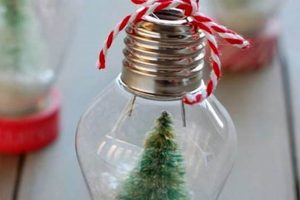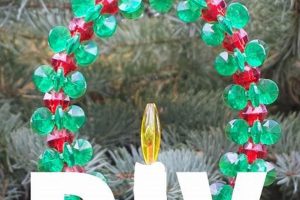Creating personalized holiday decorations through crafting photograph-embedded adornments represents a popular seasonal activity. This involves using printed images, often family portraits or cherished memories, to construct unique keepsakes for festive trees or decorative displays. Common methods include encapsulating photographs within glass, crafting them into shaped paper ornaments, or transferring images onto wooden surfaces.
The practice of producing custom decorative items offers several advantages. It provides a tangible connection to personal history and relationships, transforming standard decorations into meaningful expressions of individual identity. Furthermore, engaging in such creative endeavors can foster a sense of accomplishment and provide opportunities for shared experiences within families. Historically, crafting personal ornaments has served as a way to personalize celebrations and pass down traditions through generations.
The subsequent sections will delve into various techniques for producing these customized decorations, covering material selection, step-by-step construction methods, and options for personalization and embellishment to achieve diverse aesthetic outcomes. It will also discuss safety considerations and potential challenges in the crafting process.
Guidance for Photograph-Integrated Decorative Projects
The following recommendations are presented to ensure successful creation of photograph-integrated decorative items. Adherence to these guidelines will promote durable, aesthetically pleasing results.
Tip 1: Image Resolution is Paramount. Select digital photographs with a high resolution to avoid pixelation when printed. Aim for a minimum of 300 DPI for optimal clarity. Lower resolutions may result in blurry or distorted images, detracting from the ornament’s visual appeal.
Tip 2: Consider Material Compatibility. When affixing images to various surfaces, utilize adhesives specifically designed for the materials in question. Incompatible adhesives may fail to bond properly, leading to detachment or damage to the photograph and supporting structure. Test the adhesive on a small, inconspicuous area first.
Tip 3: Employ Protective Coatings. Apply a sealant or varnish to the finished ornament to safeguard the photograph from moisture, fading, and physical abrasion. Select a non-yellowing formula to prevent discoloration over time. Several thin coats are preferable to one thick coat to avoid drips and uneven coverage.
Tip 4: Incorporate Archival Materials. For ornaments intended as long-term keepsakes, utilize acid-free papers and inks. These materials minimize the risk of degradation over extended periods, preserving the integrity of the photograph and preventing yellowing or embrittlement.
Tip 5: Precise Cutting and Alignment. Ensure accurate trimming of the photograph to fit the ornament’s dimensions. Employ a cutting mat and sharp blade for clean, precise cuts. Careful alignment during attachment is crucial for a professional-looking result.
Tip 6: Test and Adjust Techniques. Prior to commencing the final project, practice the chosen technique on scrap materials. This allows for refinement of skills and identification of potential challenges before committing to valuable resources.
Tip 7: Monitor Drying Times. Allow adequate drying time for all adhesives and coatings before handling the ornament. Premature handling can result in smudging, fingerprints, or compromised adhesion, necessitating rework.
By following these directives, one can maximize the longevity and visual impact of personalized photograph-integrated decorative items. These ornaments serve as lasting mementos, preserving cherished memories for years to come.
The concluding section will summarize the benefits and long-term viability of photograph-integrated decorative items, highlighting their sentimental and aesthetic value.
1. Image Selection
The selection of appropriate images forms the foundation for successful construction of photograph-embedded decorative items. The quality and content of the chosen photograph directly influence the aesthetic appeal and sentimental value of the finished product. Thoughtful consideration of several factors is necessary to ensure optimal results.
- Resolution and Clarity
Image resolution dictates the level of detail visible when the photograph is printed or displayed. A low-resolution image will appear pixelated or blurry, detracting from the ornament’s visual quality. It is recommended to utilize images with a minimum resolution of 300 DPI to ensure sharpness and clarity, particularly when printing the image at a size suitable for ornament construction. The pixel density is critical in achieving professional appearance and retaining visual fidelity.
- Content and Composition
The subject matter of the photograph should align with the intended purpose and recipient of the ornament. Family portraits, scenic landscapes, or depictions of cherished memories are common choices. The composition of the photograph, including the arrangement of elements within the frame, should be aesthetically pleasing and contribute to the overall design. Consider cropping the photograph to emphasize specific details or remove distracting elements.
- Color and Tone
The color palette and tonal range of the photograph influence the visual impact of the ornament. Vibrant colors and strong contrasts can create a dynamic and eye-catching effect, while muted tones and subtle gradients may evoke a sense of nostalgia or tranquility. Color correction and tonal adjustments can be applied during the image editing process to enhance the photograph’s visual appeal and ensure it complements the chosen materials and design elements.
- Copyright and Usage Rights
When incorporating photographs taken by others, it is essential to ensure that one has the appropriate usage rights. Using copyrighted images without permission can result in legal consequences. If utilizing images from online sources, carefully review the licensing terms and conditions to determine whether commercial or personal use is permitted. Whenever possible, opt for original photographs or those licensed under Creative Commons or similar agreements.
The process of selecting appropriate images for photograph-embedded decorative items extends beyond mere personal preference; it requires careful consideration of technical specifications, artistic principles, and legal considerations. The deliberate selection of high-quality and contextually relevant images is paramount to the creation of meaningful and visually appealing ornaments.
2. Material Compatibility
Material compatibility is a foundational consideration in the construction of durable and visually appealing photograph-integrated decorative items. The successful long-term integration of photographic elements with diverse crafting materials necessitates a thorough understanding of the chemical and physical interactions between the various components. Failure to account for these interactions can result in structural failure, aesthetic degradation, and ultimately, the premature demise of the crafted object.
- Adhesive Selection
The choice of adhesive is paramount in securing the photograph to the substrate. Adhesives must exhibit sufficient bonding strength to withstand environmental stressors such as temperature fluctuations and humidity. Furthermore, the chemical composition of the adhesive must be compatible with both the photograph’s surface (typically coated paper or film) and the substrate material (wood, glass, metal, plastic, etc.). Acidic adhesives, for example, can cause discoloration and degradation of photographs over time. Opting for pH-neutral or archival-quality adhesives is essential for long-term preservation. Examples include PVA (polyvinyl acetate) adhesives for porous surfaces like wood and specialized photo-mounting adhesives for delicate papers. Incompatibility can manifest as peeling, bubbling, or staining.
- Coating Compatibility
Protective coatings, such as varnishes, sealants, or laminates, are often applied to photograph-integrated ornaments to shield the image from environmental damage and physical abrasion. However, the compatibility of the coating with the photograph’s ink and surface is critical. Certain coatings can cause the ink to bleed, smear, or fade. Others may react adversely with the photograph’s surface, resulting in clouding, cracking, or delamination. Testing the coating on a small, inconspicuous area of the photograph is advisable prior to full application. Water-based acrylic varnishes are generally considered safe for use with most photographic prints, but solvent-based coatings require careful evaluation.
- Substrate Material Properties
The properties of the chosen substrate material influence the selection of appropriate adhesives and coatings. Porous materials like wood require adhesives that can penetrate the surface and create a strong mechanical bond. Non-porous materials like glass or metal necessitate adhesives that form a strong chemical bond. The substrate’s thermal expansion coefficient should also be considered, particularly in environments with significant temperature variations. Differential expansion and contraction between the photograph and the substrate can lead to stress and eventual delamination. Examples include using gesso on canvas before applying an image transfer or choosing a metal ornament base that wont expand much under temperature fluctuations.
- Print Media Considerations
Different photographic print media exhibit varying levels of sensitivity to environmental factors and chemical interactions. Glossy prints, for example, tend to be more resistant to moisture and abrasion than matte prints. However, glossy surfaces may also be more prone to trapping air bubbles during lamination or coating. The type of ink used in the printing process also influences the selection of compatible materials. Dye-based inks are generally more susceptible to fading than pigment-based inks. Understanding the specific properties of the chosen print media is crucial for selecting appropriate adhesives and coatings that will ensure long-term preservation of the photograph.
In summary, the successful integration of photographs into decorative ornaments hinges on a comprehensive understanding of material compatibility. Careful consideration of adhesive selection, coating compatibility, substrate material properties, and print media considerations is essential for creating durable and visually appealing keepsakes that will withstand the test of time. Ignoring these factors can lead to premature degradation and a disappointing outcome for the crafter.
3. Cutting Precision
In the realm of photograph-integrated decorative items, specifically within the context of crafting personalized ornaments, cutting precision holds paramount importance. Its influence manifests directly in the aesthetic quality and overall structural integrity of the final product. Inaccurate cuts result in misalignment, uneven edges, and compromised integration with the chosen base material. For example, when creating a glass-encased ornament, a photograph cut imprecisely will not sit flush against the glass, creating visible gaps and detracting from the ornament’s visual appeal. Similarly, when adhering a photograph to a wooden shape, imprecise cuts can lead to overhanging edges that are prone to peeling or damage. The dimensional accuracy of the photograph is thus a direct determinant of the final ornament’s professional appearance and longevity. A lack of cutting precision introduces avoidable flaws, undermining the intended visual harmony and craftsmanship of the endeavor.
The practical significance of cutting accuracy extends beyond mere aesthetics. Precise cutting facilitates a secure and lasting bond between the photograph and the chosen substrate. An accurately cut photograph allows for uniform distribution of adhesive, ensuring consistent adhesion across the entire surface. This, in turn, minimizes the risk of air pockets, wrinkles, or eventual detachment. Furthermore, accurate cutting simplifies the process of incorporating the photograph into complex ornament designs. Whether using a die-cutting machine for intricate shapes or hand-cutting for simpler forms, precision enables seamless integration and prevents the need for remedial adjustments or corrections. A tangible example is the creation of multi-layered ornaments; consistent and accurate cuts are essential for proper alignment and structural stability of the assembled pieces.
In conclusion, cutting precision is not merely a technical detail but a foundational element in the successful production of photograph-integrated decorative items. The challenges associated with achieving accurate cuts can be mitigated through the use of appropriate tools, careful measurement, and meticulous execution. Addressing this facet directly contributes to the creation of high-quality, visually appealing ornaments that serve as enduring expressions of personal memories. Its mastery is indispensable for anyone seeking to elevate the quality and longevity of their crafted photograph ornaments.
4. Adhesive Strength
Adhesive strength represents a critical factor in the construction and longevity of photograph-integrated decorative items. The selection and application of an appropriate adhesive directly impacts the structural integrity and visual appeal of the final product, determining its ability to withstand environmental stressors and maintain its intended form over time.
- Substrate Compatibility
The adhesive’s capacity to bond effectively with the specific materials employed, such as wood, glass, metal, or plastic, directly determines the ornament’s durability. For instance, an adhesive formulated for porous surfaces may fail to adhere adequately to a non-porous surface, leading to detachment. Conversely, a rigid adhesive may lack the flexibility required for substrates prone to expansion and contraction, resulting in cracking or delamination.
- Environmental Resistance
The selected adhesive must withstand exposure to environmental factors, including temperature fluctuations, humidity, and ultraviolet radiation. Failure to consider these factors can result in adhesive degradation, weakening the bond between the photograph and the substrate. Ornaments intended for outdoor display, for example, require adhesives specifically formulated for weather resistance to prevent premature failure.
- Photo-Reactivity Considerations
Certain adhesives contain chemicals that can react negatively with photographic materials, causing discoloration, fading, or degradation of the image. Adhesives labeled as “photo-safe” or “archival quality” minimize this risk by utilizing inert compounds that will not harm the photograph over time. The use of non-archival adhesives can compromise the long-term preservation of the embedded photograph.
- Application Technique
The method of adhesive application significantly impacts the bond’s overall strength. Uneven application, insufficient coverage, or the presence of air pockets can weaken the adhesive bond and create points of vulnerability. Proper surface preparation, including cleaning and degreasing, is essential for optimal adhesion. Following the manufacturer’s instructions regarding application technique and curing time is critical for achieving the desired bond strength.
The sustained integrity of photograph-integrated decorative items hinges upon the careful selection and application of an adhesive possessing adequate strength and compatibility with the chosen materials and intended environment. Failure to prioritize adhesive strength can result in premature deterioration of the ornament, diminishing its aesthetic value and undermining its purpose as a lasting keepsake.
5. Protective Coating
Protective coatings applied to photograph-integrated decorative items significantly influence their longevity and visual quality. These coatings act as a barrier against environmental factors such as ultraviolet radiation, moisture, and physical abrasion, all of which can degrade the photographic image and the surrounding crafting materials. The absence of a protective coating can lead to fading, discoloration, scratching, and ultimately, the destruction of the ornament. For instance, a photograph directly exposed to sunlight will fade substantially faster than one shielded by a UV-resistant coating. Similarly, an ornament subjected to handling and storage will exhibit more surface wear and tear without a protective layer. The type of coating selected must be compatible with both the photographic print and the ornament substrate to prevent adverse reactions such as clouding, cracking, or peeling. The application process itself necessitates careful execution to avoid imperfections like bubbles or uneven coverage, which can compromise the coating’s protective function and detract from the ornament’s aesthetic appeal.
Practical application of protective coatings involves several stages. The surface of the photograph and substrate must be clean and free of debris to ensure proper adhesion. The coating is then applied in thin, even layers, allowing sufficient drying time between each coat. Multiple coats often provide enhanced protection compared to a single, thick application. Different types of coatings offer varying levels of protection and aesthetic finishes. Acrylic-based coatings are commonly used for their durability and clarity, while varnish provides a more traditional, glossy finish. Laminates offer a physical barrier against scratches and moisture but may alter the texture and appearance of the photograph. Selecting the appropriate coating depends on the specific materials used in the ornament, the desired aesthetic outcome, and the anticipated environmental conditions to which the ornament will be exposed. Consideration should also be given to the ease of application and the potential for reversibility, should the coating need to be removed or replaced in the future.
In summary, the implementation of a protective coating is an indispensable step in the creation of durable and visually enduring photograph-integrated decorative items. By shielding the photograph and substrate from environmental damage, these coatings prolong the ornament’s lifespan and preserve its aesthetic integrity. Challenges associated with coating selection and application can be mitigated through careful research, testing, and adherence to best practices. This practice ensures that these personalized keepsakes can be enjoyed for years to come, maintaining their visual appeal and sentimental value.
6. Hanging Mechanism
The hanging mechanism is an integral component of photograph-integrated decorative items. Its functionality and aesthetic integration are paramount to the ornament’s display and overall appeal, influencing both its physical presentation and perceived value.
- Material Selection and Durability
The choice of material for the hanging mechanism, such as wire, ribbon, string, or metal hooks, directly impacts the ornament’s ability to be securely displayed. The material must possess sufficient tensile strength to support the weight of the ornament without breaking or deforming. For example, a delicate paper ornament featuring a photograph may require a lightweight ribbon, whereas a heavier glass or ceramic ornament necessitates a more robust wire or metal hook. Durability is essential to prevent the ornament from falling and potentially being damaged. Failure to consider material strength can lead to immediate display issues or eventual degradation, reducing the ornament’s lifespan and visual presentation.
- Attachment Method and Security
The method by which the hanging mechanism is affixed to the ornament is crucial for ensuring long-term security. Whether using glue, wire loops, eyelets, or integrated hooks, the attachment point must be strong and resistant to detachment. For instance, a poorly glued ribbon loop may separate from the ornament with minimal stress, whereas a securely embedded eyelet provides a more permanent and reliable connection. The chosen method should also minimize stress on the ornament’s structure, preventing cracks or fractures. Incorrect attachment techniques can compromise the ornament’s stability and pose a risk of damage during handling or display.
- Aesthetic Integration and Visual Harmony
The hanging mechanism should complement the ornament’s overall design and not detract from its aesthetic appeal. The color, texture, and style of the hanging mechanism should harmonize with the photograph and surrounding materials. For example, a rustic wooden ornament might benefit from a natural twine or leather cord, while a modern metallic ornament may be enhanced by a sleek metal hook. A visually discordant hanging mechanism can detract from the ornament’s perceived value and create a sense of imbalance. Careful consideration of aesthetic integration enhances the ornament’s visual appeal and creates a cohesive design.
- Length and Adjustability
The length of the hanging mechanism influences the ornament’s position when displayed and can affect its visibility and presentation. A hanging mechanism that is too short may cause the ornament to be obscured by branches or other decorations, while one that is too long may allow the ornament to swing excessively or hang at an undesirable angle. Adjustable hanging mechanisms, such as those with sliding knots or adjustable hooks, offer greater flexibility in positioning the ornament. Careful consideration of length and adjustability ensures optimal visibility and display of the ornament.
These interconnected facets regarding hanging mechanism demonstrate its profound relationship with the overall quality and presentation of photograph-integrated decorative items. From a functional perspective, secure and durable mechanisms prevent damage and ensure proper display. Aesthetically, the choice of materials and attachment styles contributes to the ornament’s overall visual harmony. Consequently, thoughtful consideration of the hanging mechanism is essential for crafting personalized ornaments that are both visually appealing and structurally sound.
7. Design Personalization
Design personalization serves as a critical component in the crafting of photograph-integrated decorative items. This aspect elevates the project from a mere crafting exercise to a meaningful expression of individuality and sentiment. The ability to customize the design allows for the creation of ornaments that reflect personal memories, tastes, and relationships. The absence of design personalization transforms the outcome into a generic product lacking emotional resonance. As an illustration, a simple square ornament becomes significantly more impactful when personalized with specific colors, embellishments, and photograph arrangements that are meaningful to the recipient. The resulting ornament transcends its functional purpose, becoming a unique and cherished keepsake.
The practical application of design personalization manifests in various techniques and approaches. The selection of specific materials, such as patterned paper, decorative beads, or custom-shaped frames, contributes to the overall aesthetic and conveys a particular style. Digital manipulation of the photograph itself, including the addition of filters, text overlays, or collage effects, further enhances the personalization. Real-world examples include ornaments designed to commemorate specific events, such as weddings or graduations, featuring corresponding colors and thematic elements. Furthermore, the incorporation of handwritten messages or signatures adds a tactile and intimate dimension to the design. Understanding the possibilities for design personalization empowers creators to tailor each ornament to the intended recipient, maximizing its emotional impact and sentimental value.
In conclusion, design personalization is not merely an optional embellishment but an essential ingredient in the creation of meaningful and lasting photograph-integrated decorative items. Its application transforms a simple craft project into a unique expression of personal connection. The challenges associated with design personalization, such as selecting appropriate materials and techniques, are outweighed by the profound emotional impact and enduring value of the resulting ornament. The integration of thoughtful design choices elevates the project from a simple crafting exercise to a cherished keepsake that captures and preserves personal memories.
Frequently Asked Questions About Photograph-Integrated Decorative Item Construction
The following section addresses common inquiries regarding the creation of customized photograph ornaments. The intent is to provide clarity on essential aspects of the crafting process.
Question 1: What constitutes a suitable adhesive for securing photographs to wooden ornaments?
Adhesives specifically formulated for bonding paper to wood are recommended. Polyvinyl acetate (PVA) glues are generally appropriate, provided they are acid-free to prevent photograph degradation. Avoid solvent-based adhesives, as these may damage the photograph’s surface.
Question 2: How does image resolution affect the visual quality of photograph ornaments?
Higher resolution images yield superior print quality and clarity. A minimum resolution of 300 DPI (dots per inch) is advised for producing sharp, detailed photographs suitable for ornament construction. Lower resolutions may result in pixelation and a reduction in visual fidelity.
Question 3: What measures should be taken to protect photograph ornaments from fading?
Applying a UV-resistant coating or sealant is essential for mitigating fading caused by ultraviolet radiation. The ornament should also be stored away from direct sunlight when not in use. Archival-quality printing materials further enhance resistance to fading over extended periods.
Question 4: How should photographs be prepared for integration into glass ornaments?
Photographs intended for glass ornaments should be precisely trimmed to match the ornament’s dimensions. Lamination can provide added protection against moisture and handling. Care must be taken to avoid air bubbles during the insertion process.
Question 5: What are the recommended techniques for preventing air bubbles during adhesive application?
Apply adhesive in thin, even layers, utilizing a brayer or roller to smooth the photograph onto the substrate. Work from the center outwards to displace any trapped air. Allow adequate drying time to minimize the risk of air pockets forming post-application.
Question 6: How can an individual ensure the chosen hanging mechanism is secure and aesthetically appropriate?
The hanging mechanism should be constructed from a durable material capable of supporting the ornament’s weight. Attachment points should be reinforced. The style and color of the mechanism should complement the ornament’s overall design to maintain visual harmony.
The preceding queries represent a selection of frequently encountered concerns related to photograph ornament creation. Diligent attention to these points will contribute to the production of high-quality, lasting keepsakes.
The subsequent portion will provide a summary of the benefits and creative potential associated with photograph-integrated decorative item construction.
Conclusion
The preceding discourse has illuminated the multifaceted aspects of photograph-integrated decorative item construction, commonly referenced as “picture ornaments diy.” From considerations of image resolution and material compatibility to the importance of adhesive strength, cutting precision, protective coatings, secure hanging mechanisms, and individualized design choices, the meticulous application of informed practices yields a lasting, personalized keepsake. The discussed principles, when diligently applied, mitigate potential structural and aesthetic compromises.
Engaging in “picture ornaments diy” offers a tangible means of preserving memories and fostering creative expression. It is imperative that individuals undertaking such projects approach them with a deliberate focus on quality materials, sound techniques, and an understanding of the underlying principles. By doing so, they contribute to the creation of lasting heirlooms that transcend mere decoration and embody enduring sentimental value.







